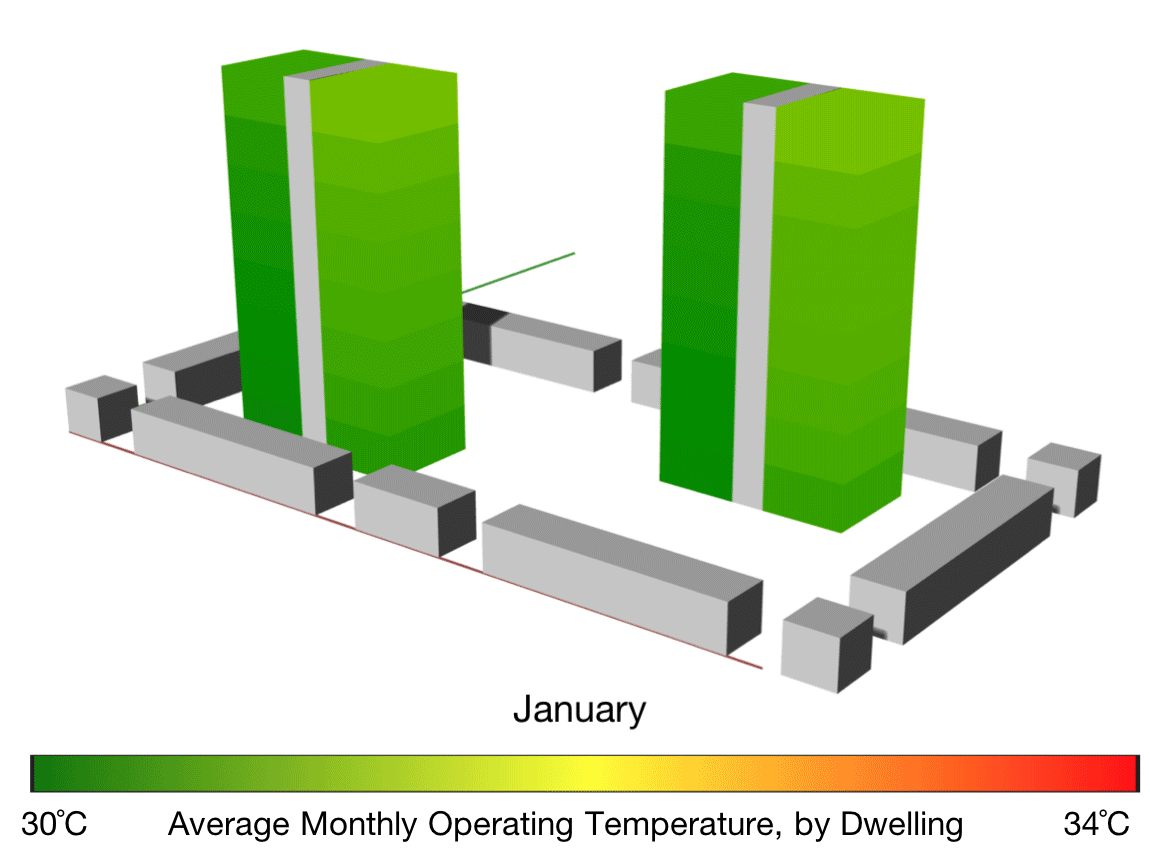RESEARCH (and related side projects)
In the summer of 2021, I completed my PhD in the Urban Informatics Lab at Stanford University. Working under the advisory of Rishee Jain, my research focused on developing social-technical solutions for urban sustainability problems in both the developed and developing worlds.
Building energy consumption can be affected by its urban context, including phenomena such as shading (blue), heat transfer (red), and urban heat island effect (yellow).
DUE-S: Data-driven urban Energy Simulation
The world is rapidly urbanizing. As a result, cities will need to be created and expanded to accommodate their growing populations – putting great pressure on enhancing their energy sustainability for the future. However, one of the biggest challenges to improving the energy efficiency of urban buildings is our inability to capture the “urban context” associated with building energy use – the inter-building effects, urban microclimates, and modeling assumptions required to model and predict a building’s energy performance.
My research focused on developing an integrated simulation-based and data-driven methodology to accurately predict building energy consumption in urban areas.
JOURNAL PUBLICATIONS
CONFERENCE PRESENTATIONS
“Multi-scale pathways for reducing urban heat and building-scale energy inequities across cities.” Presented at 6th International Conference on Countermeasures to Urban Heat Islands (IC2UHI) 2023. Melbourne, Australia. Dec 2023.
“Context-aware urban energy efficiency optimization using hybrid physical models.” Presented at Neural Information Processing Systems (NeurIPS) 2020. Virtual. Dec. 2020. and Presented at Climate Change AI 2020. Virtual. 2020.
Average monthly operating temperature, by dwelling unit.
PARAmetric design analysis for informal settlement redevelopment
By 2030, it is expected that 2 billion people will be living in informal settlements, or “slums,” across the world. These communities are characterized by poor quality of life with regard to lack of sufficient living area, inadequate thermal comfort and inequitable access to energy. And while it is clearly imperative we work to improve these conditions, the bulk of academic research done to understand how a building’s design affects its energy consumption and thermal comfort have been focused on developed countries.
Through this project, I looked to understand the impact different design parameters (e.g., building materials, urban morphologies) have on thermal comfort and energy consumption. My specific focus was on Dharavi – Asia’s second largest informal settlement – located in Mumbai, India.
PUBLICATIONS
Our team’s architecture for Visual Question Answering (VQA).
Attention mechanisms for visual QuEstion Answering (VQA)
Visual Question Answering, or VQA, in an increasingly popular research topic in deep learning as it tasks a model with understanding a text-based question, and, based on an accompanying image given to it, evaluate how the two inputs given to it are related – resulting in an output of an answer to the initial question about the provided image. While many attempts on addressing this challenge focus on incremental improvements to the model’s accuracy, we were interested in how to create a simpler, more interpretable model through the use of different attention mechanisms. After experimenting with 6 different attention mechanisms, our final model was able to outperform the state-of-the-art level of accuracy at the time of completion of this project.
PUBLICATIONS
Sketch model of master plan for Sailung village in Dolakha.
master planning for sailung, dolakha
In the spring of 2015, Nepal was hit by two devastating earthquakes: a 7.8 magnitude earthquake near the capital city of Kathmandu, and a 7.3 that hit the northern hill districts of the country. In the northern district of Dolakha, nearly 90% of all homes were destroyed as a result of these earthquakes. Yet three years later, many of these communities far removed from Nepal’s capital still lack the resources needed to properly rebuild their homes and livelihoods.
During the summer of 2018, I led a group of 6 Stanford engineering students to Nepal to work alongside Today’s Youth Asia – a Nepali non-profit founded by Santosh Shah – to design an eco-friendly, resilient, and economically-enriching master plan for the community of Sailung. Our designs were presented to Shanti Pakhrin – the district representative from Dolakha – as well as the national Minister for Urban Development. Our designs are currently under construction in Sailung and are expected to be completed in the next few years.
Television Feature: https://www.youtube.com/watch?v=6p8XKhHT5f8&t=3s
Press Release: https://www.youtube.com/watch?v=RRTagjm9-F8
Start.Home, pictured during installation at Jasper Ridge Biological Preserve. This is the final location for the house following the end of competition in Fall 2013.
STart.home
During the fall of my freshman year at Stanford, I joined the Start.Home project – Stanford’s first entry into the U.S. Department of Energy Solar Decathlon. I became the lead architect for the house’s bathroom – designing the layout, finishes, and lighting solution (turns out solar tubes become a great option when you have no space for windows). I built a closed-loop living wall and knee-operated sink to reduce water consumption. And, never shying away from a power tool, I made sure to get my hands dirty laying flooring, installing siding, wiring, and moving the house down to Irvine for the final competition. Out of 20 international teams, Start.Home finished 5th overall, with 1st place wins in Energy Balance and Affordability.
Project Overview: https://www.youtube.com/watch?v=GP10W7BoCx0




